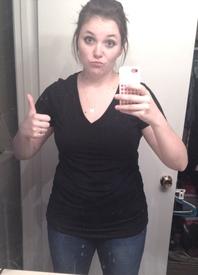HRM shows higher calories than MFP. Why????
Options

_Tuyana_
Posts: 83 Member
I'm concerned. I purchased Polar FT7 a week ago and started using its calorie count when I add my exercise to the diary, the stuff that I do is mostly cardio, but some weights incorporating cardio as well. I input my cardio as high impact, but even then MFP numbers are always lower than my HRM, same goes for weights training.
FT7 allows me to manually input my maxHR, I don't know what it is, but I saw a method posted here somewhere by heybales involving a treadmill with increasing inclines. But I don't know what to do afterwards, do I put my maxHR that I get from the test in instead of preset 191 (I'm 29 y.o.), what about heart rate upper limit, what do I do with that? and does it have any bearing on the accuracy of HRM calorie count? Please HELP!!!
FT7 allows me to manually input my maxHR, I don't know what it is, but I saw a method posted here somewhere by heybales involving a treadmill with increasing inclines. But I don't know what to do afterwards, do I put my maxHR that I get from the test in instead of preset 191 (I'm 29 y.o.), what about heart rate upper limit, what do I do with that? and does it have any bearing on the accuracy of HRM calorie count? Please HELP!!!
0
Replies
-
My Ft7 comes up with bigger numbers, too.
keep in mind it isn't programmed for weight training, so it is inaccurate for that.0 -
I understand, but I still want a reasonably accurate guesstimate of my cardio workouts, at the moment I'm not sure whether I'm doing everything right or now
 0
0 -
MFP estimates your calorie burn.
Your HRM estimates your calorie burn, but it has a but if extra data to work with (maybe, it depends on your HRM, not all of them use heart rate to determine calories).
The only thing you can do is pick an estimate and use those numbers for a month or so. See how your weight loss progresses and change things around if you need to based on your results.0 -
I understand, but I still want a reasonably accurate guesstimate of my cardio workouts, at the moment I'm not sure whether I'm doing everything right or now

The only real way to get a baseline is to use an oxygen analyzer.0 -
I'm concerned. I purchased Polar FT7 a week ago and started using its calorie count when I add my exercise to the diary, the stuff that I do is mostly cardio, but some weights incorporating cardio as well. I input my cardio as high impact, but even then MFP numbers are always lower than my HRM, same goes for weights training.
FT7 allows me to manually input my maxHR, I don't know what it is, but I saw a method posted here somewhere by heybales involving a treadmill with increasing inclines. But I don't know what to do afterwards, do I put my maxHR that I get from the test in instead of preset 191 (I'm 29 y.o.), what about heart rate upper limit, what do I do with that? and does it have any bearing on the accuracy of HRM calorie count? Please HELP!!!
The HRmax stat has big bearing on calorie burn estimate.
What if you avg 150 bpm for 1 hr in a workout. If HRmax (the fastest your heart literally can go) is 191, that's 79% of max, decent effort, decent calorie burn estimate.
But if HRmax is really 175 for you, then that is 86% of max, and that is a big effort, and big calorie burn.
So getting that stat best estimated has a big effect on calorie burn.
HRmax will increase to true level about 2-3 weeks after you start working out, but at that point, genetically set and age has a factor, as you get older it will lower slowly.. You may have a fast Honda heart, or a slow diesel heart, on the upper end. I've had HRmax 194 for years, though by age at this point, default would be 177 in HRM.
The lower end for resting HR is somewhat genetic, but exercise has much more effect to lowering it.
Regarding MFP, walking level at the speeds it has is really accurate, more than your HRM actually. Other activities that don't have descriptions, like walking at an incline even, MFP can't be accurate with.
But you actually nailed a great test that can be done on your HRM, because HRmax is one stat, the other important one is one we can't change on the FT7 - VO2max. I'm still working on how to tweak available settings to in essence change that unviewable stat.
Here's the test. Walk flat for 35 min at 4mph. First 5 is warmup, start the HRM logging for last 30 min. Note the treadmill estimate of calories, it just needs your weight to be accurate.
Take your info to here and see what the calculator says the energy use would really be.
Lets you see how close your HRM is.
http://www.exrx.net/Calculators/WalkRunMETs.html
Weight lifting, waiting about 1 min between sets, 2 between lifts, is about 1/4 to 1/3 what the Polar reports. Just wear it a couple times to see about how many calories it appears you burn, and you can use that estimate going forward. MFP actually estimates really well on strength training for me.
If you are doing weights, leave the cardio out of it. Adding cardio ruins the ability to make it a good weight lifting workout.
HRM Upper Limit is merely for training. If you want to stay in say the Recovery HR zone for cardio the day following weight lifting, then you set that value. Or you want a long Aerobic HR zone workout, can set that value. It'll tell you when you've gone over. Forgot if it's audible or not.0 -
....The HRmax stat has big bearing on calorie burn estimate.
What if you avg 150 bpm for 1 hr in a workout. If HRmax (the fastest your heart literally can go) is 191, that's 79% of max, decent effort, decent calorie burn estimate.
But if HRmax is really 175 for you, then that is 86% of max, and that is a big effort, and big calorie burn.
So getting that stat best estimated has a big effect on calorie burn.
HRmax will increase to true level about 2-3 weeks after you start working out, but at that point, genetically set and age has a factor, as you get older it will lower slowly.. You may have a fast Honda heart, or a slow diesel heart, on the upper end. I've had HRmax 194 for years, though by age at this point, default would be 177 in HRM.
The lower end for resting HR is somewhat genetic, but exercise has much more effect to lowering it.
...
Ok, so how do you know your HRmax is 194? If you aren't using the age based forumlas that give you 177, how did you determine it?0 -
What's the problem? Enter in the calories from your HRM. MFP doesn't know your conditioning level or the intensity of your exercise. So it's a vague guess at best.0
-
What's the problem? Enter in the calories from your HRM. MFP doesn't know your conditioning level or the intensity of your exercise. So it's a vague guess at best.
For some exercises, like level walking, your personal fitness level only determines if it was mainly fat burning (low effort) or carb burning (high effort).
But the amount of energy required to move so much mass so far at such a pace doesn't change much at certain speeds. Unless you have some super efficient or super inefficient walking style that causes you to burn more.
At those levels - more accurate than HRM.
http://www.ncbi.nlm.nih.gov/pubmed/155701500 -
Ok, so how do you know your HRmax is 194? If you aren't using the age based forumlas that give you 177, how did you determine it?
Good 'ole puke test.
Well, not that bad actually. I was able to go do an intense (as I could make it at that point anyway) spin class afterwards.
Regretted it the next day.
Should follow a rest day, no soreness from weight lifting should be left, should be well rested, should be cool not overly hot (for the VO2max estimate part of it, don't want heat-elevated HR effects).
http://www.myfitnesspal.com/topics/show/466973-i-want-to-test-for-my-max-heart-rate-vo2-max
I did the more stressful test at the end of that post. I find walking at extreme grades fast (and treadmill doesn't go high enough anyway) sets my achilles tendon to getting too tight and stopping me short.0 -
I'm concerned. I purchased Polar FT7 a week ago and started using its calorie count when I add my exercise to the diary, the stuff that I do is mostly cardio, but some weights incorporating cardio as well. I input my cardio as high impact, but even then MFP numbers are always lower than my HRM, same goes for weights training.
FT7 allows me to manually input my maxHR, I don't know what it is, but I saw a method posted here somewhere by heybales involving a treadmill with increasing inclines. But I don't know what to do afterwards, do I put my maxHR that I get from the test in instead of preset 191 (I'm 29 y.o.), what about heart rate upper limit, what do I do with that? and does it have any bearing on the accuracy of HRM calorie count? Please HELP!!!
None of it matters until you get below 12% body fat anyway. Don't worry about it. None if it is accurate. You burn far less than any of it.0 -
MFP estimates and it has no idea if 60 minutes of elliptical means no rests at all, or what pace, etc. So it just gives an estimate.
your HRM is actually measuring your heart rate, so it's taking into account if you're going really hard, or decently hard, or if you're taking a lot of breaks, etc.0 -
I understand, but I still want a reasonably accurate guesstimate of my cardio workouts, at the moment I'm not sure whether I'm doing everything right or now

Use your HRM for the cardio workouts, but not the weights, HRMs are only intended to be used for steady state cardio, they will most likely over estimate every other type of exercise.0 -
The HRmax stat has big bearing on calorie burn estimate.
What if you avg 150 bpm for 1 hr in a workout. If HRmax (the fastest your heart literally can go) is 191, that's 79% of max, decent effort, decent calorie burn estimate.
But if HRmax is really 175 for you, then that is 86% of max, and that is a big effort, and big calorie burn.
So getting that stat best estimated has a big effect on calorie burn.
HRmax will increase to true level about 2-3 weeks after you start working out, but at that point, genetically set and age has a factor, as you get older it will lower slowly.. You may have a fast Honda heart, or a slow diesel heart, on the upper end. I've had HRmax 194 for years, though by age at this point, default would be 177 in HRM.
The lower end for resting HR is somewhat genetic, but exercise has much more effect to lowering it.
Thanks! One of these days I'll do that treadmill test, when I'm not sore.HRM Upper Limit is merely for training. If you want to stay in say the Recovery HR zone for cardio the day following weight lifting, then you set that value. Or you want a long Aerobic HR zone workout, can set that value. It'll tell you when you've gone over. Forgot if it's audible or not.
I don't think it's audible0 -
Thanks everyone for your input!0
This discussion has been closed.
Categories
- All Categories
- 1.4M Health, Wellness and Goals
- 396.9K Introduce Yourself
- 44.2K Getting Started
- 260.9K Health and Weight Loss
- 176.3K Food and Nutrition
- 47.6K Recipes
- 232.8K Fitness and Exercise
- 452 Sleep, Mindfulness and Overall Wellness
- 6.5K Goal: Maintaining Weight
- 8.7K Goal: Gaining Weight and Body Building
- 153.3K Motivation and Support
- 8.3K Challenges
- 1.3K Debate Club
- 96.5K Chit-Chat
- 2.6K Fun and Games
- 4.5K MyFitnessPal Information
- 16 News and Announcements
- 18 MyFitnessPal Academy
- 1.4K Feature Suggestions and Ideas
- 3.1K MyFitnessPal Tech Support Questions







